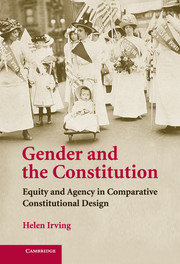9 - International and Customary Law
Published online by Cambridge University Press: 08 December 2009
Summary
The provisions in a country's legal instruments or body of case law do not exhaust the sources – potential or actual – of that country's law. Alternative legal systems, both external and internal to the state, create pressure on or even directly shape national law. International and supranational instruments – treaties, conventions, and “soft law” (authoritative statements of principle, not yet incorporated into conventions or treaties) – are increasingly present in legal debate and decision making. Within many legal systems, subnational, nonstate laws – customary and religious – also require recognition. In considering constitutional design from the perspective of gender, these sources of law cannot be overlooked.
The whole body of international law, without precision, encompasses a very wide range of types of supranational law, both customary international and treaty law, private and public. Since the 1980s, in particular, feminist analysis has been applied extensively to international law. Typically, this analysis has focused on a subsection of the body of international law, namely, the multilateral United Nations (or other supranational) conventions on human rights and, occasionally, universal human rights norms. The focus of this chapter is also on this sphere of international law.
Although some constitutions, as we see later in the chapter, refer generically to “international law,” some others make this focus clear by expressly identifying international law as relevant to domestic law with respect specifically to human rights. For example, Article 93 of the Colombian Constitution provides that
International treaties and conventions ratified by the Congress that recognise human rights … have prevalence in the internal order. […]
- Type
- Chapter
- Information
- Gender and the ConstitutionEquity and Agency in Comparative Constitutional Design, pp. 219 - 250Publisher: Cambridge University PressPrint publication year: 2008



